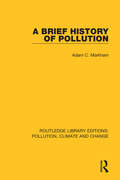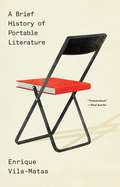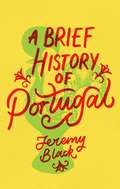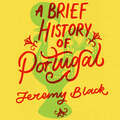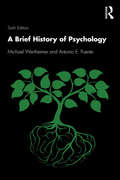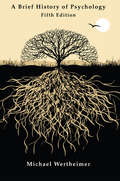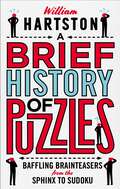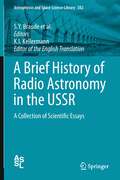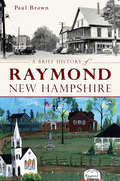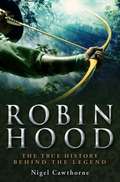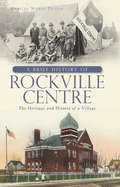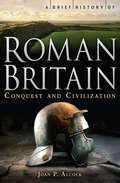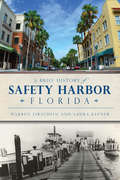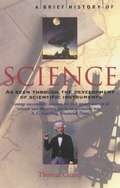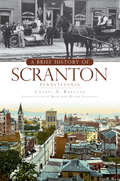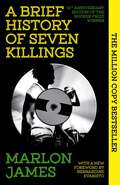- Table View
- List View
A Brief History of Pirates and Buccaneers
by Tom BowlingFrom Stevenson's Treasure Island to Pirates of the Caribbean, the romantic image of pirates in popular culture has long been with us. But pirates are not all as charming as Johnny Depp. In ancient times Thracians, Cilicians and Illyrians terrorised traders in the Mediterranean, while the Barbary pirates of North Africa instilled fear wherever they went from the Holy Lands to the coast of Ireland. It was not until the age of Discovery, when ships began to cross the Atlantic carrying unimaginable riches from the New World that the traditional image of the buccaneering pirate was created. In England, heroes such as Sir Francis Drake were feted for their exploits against the Spanish fleet in which piracy was little more than state-sponsored terrorism. Tom Bowling's lively history explores many of the myths and true stories about the notorious outlaws of the oceans: including Captain Kidd, Blackbeard as well as Mary Read and other famous female pirates.
A Brief History of Pollution
by Adam C. MarkhamOriginally published in 1994, this book links the distant past with the urgent problems of today, taking the reader on a literary and scientific tour of global pollution from pre-history to the post-industrial age. Ancient problems such as lead poisoning in Rome and water pollution in Mesopotamia provide the background to a discussion of modern catastrophes including the hole in the ozone layer, climate change and the global drinking water crisis. The book chronicles 800 years of pollution in London, charts the growth of environmental activism and spotlights the rise of the consumer society as the driving force behind today’s malaise.
A Brief History of Portable Literature
by Enrique Vila-Matas Anne Mclean Thomas BunsteadA reader's fictional tour of the art and lives of some of the great 20th-century Surrealists An author (a version of Vila-Matas himself) presents a short "history" of a secret society, the Shandies, who are obsessed with the concept of "portable literature." The society is entirely imagined, but in this rollicking, intellectually playful book, its members include writers and artists like Marcel Duchamp, Aleister Crowley, Witold Gombrowicz, Federico García Lorca, Man Ray, and Georgia O'Keefe. The Shandies meet secretly in apartments, hotels, and cafes all over Europe to discuss what great literature really is: brief, not too serious, penetrating the depths of the mysterious. We witness the Shandies having adventures in stationary submarines, underground caverns, African backwaters, and the cultural capitals of Europe.
A Brief History of Portugal: Indispensable for Travellers
by Jeremy BlackThis is a comprehensive history of Portugal that covers the whole span, from the Stone Age to today. An introduction provides an understanding of geographical and climatic issues, before an examination of Portugal's prehistory and classical Portugal, from the Stone Age to the end of the the Roman era.Portugal's history from ad420 to the thirteenth century takes in the Suevi, Visigoths and Moors. Then, a look at medieval Portugal, covers the development of Christian Portugal culminating with the expulsion of the Moors, with a focus on key sites. A subsequent section on Spanish rule, between 1580 and 1640, explains why Spain took over and why Spanish rule collapsed.There is a significant focus on Portugal's global role, particularly during the age of exploration, or expansion, in the fifteenth century to 1580: Manueline Portugal, Henry the Navigator, Vasco da Gama and Belém. Portugal was the first of the Atlantic empires, with territory in the Azores, Madeira, West Africa and Brazil, and it remained a major empire until the 1820s, retaining an African empire until the 1970s. It's empire in Asia - in Malacca, Macao, Goa and Timor - continued even longer, until the 1990s. Black shows how Portugal had a global impact, but the world, too, had an impact on Portugal. Baroque Portugal, between 1640 and 1800, is explored through palaces in Mafra, Pombal and elsewhere and the wealth of Brazil. The nineteenth century brought turmoil in the form of a French invasion, the Peninsular War, Brazilian independence, successive revolutions, economic issues and the end of the monarchy.Republican Portugal brought further chaos in the early years of the twentieth century, then the dictatorship of Salazar and its end in the Carnation Revolution of 1974. Portugal's role in both world wars is examined, also its wars in Africa. From the overthrow of autocracy to a new constitution and the leadership of Soares, contemporary, democratic Portugal is explored, including the fiscal crisis of recent years. Throughout Black introduces the history and character of the country's principal regions, including the Azores, Madeira and the Cape Verde Islands. He looks at key national sites, at Portuguese food and wine and the arts, with special sections devoted to port, Portugal's famous tiles and the university established at Coimbra in 1290.
A Brief History of Portugal: Indispensable for Travellers
by Jeremy BlackThis is a comprehensive history of Portugal that covers the whole span, from the Stone Age to today. An introduction provides an understanding of geographical and climatic issues, before an examination of Portugal's prehistory and classical Portugal, from the Stone Age to the end of the the Roman era.Portugal's history from ad420 to the thirteenth century takes in the Suevi, Visigoths and Moors. Then, a look at medieval Portugal, covers the development of Christian Portugal culminating with the expulsion of the Moors, with a focus on key sites. A subsequent section on Spanish rule, between 1580 and 1640, explains why Spain took over and why Spanish rule collapsed.There is a significant focus on Portugal's global role, particularly during the age of exploration, or expansion, in the fifteenth century to 1580: Manueline Portugal, Henry the Navigator, Vasco da Gama and Belém. Portugal was the first of the Atlantic empires, with territory in the Azores, Madeira, West Africa and Brazil, and it remained a major empire until the 1820s, retaining an African empire until the 1970s. It's empire in Asia - in Malacca, Macao, Goa and Timor - continued even longer, until the 1990s. Black shows how Portugal had a global impact, but the world, too, had an impact on Portugal. Baroque Portugal, between 1640 and 1800, is explored through palaces in Mafra, Pombal and elsewhere and the wealth of Brazil. The nineteenth century brought turmoil in the form of a French invasion, the Peninsular War, Brazilian independence, successive revolutions, economic issues and the end of the monarchy.Republican Portugal brought further chaos in the early years of the twentieth century, then the dictatorship of Salazar and its end in the Carnation Revolution of 1974. Portugal's role in both world wars is examined, also its wars in Africa. From the overthrow of autocracy to a new constitution and the leadership of Soares, contemporary, democratic Portugal is explored, including the fiscal crisis of recent years. Throughout Black introduces the history and character of the country's principal regions, including the Azores, Madeira and the Cape Verde Islands. He looks at key national sites, at Portuguese food and wine and the arts, with special sections devoted to port, Portugal's famous tiles and the university established at Coimbra in 1290.
A Brief History of Portugal: Indispensable for Travellers
by Jeremy BlackThis is a comprehensive history of Portugal that covers the whole span, from the Stone Age to today. An introduction provides an understanding of geographical and climatic issues, before an examination of Portugal's prehistory and classical Portugal, from the Stone Age to the end of the the Roman era.Portugal's history from ad420 to the thirteenth century takes in the Suevi, Visigoths and Moors. Then, a look at medieval Portugal, covers the development of Christian Portugal culminating with the expulsion of the Moors, with a focus on key sites. A subsequent section on Spanish rule, between 1580 and 1640, explains why Spain took over and why Spanish rule collapsed.There is a significant focus on Portugal's global role, particularly during the age of exploration, or expansion, in the fifteenth century to 1580: Manueline Portugal, Henry the Navigator, Vasco da Gama and Belém. Portugal was the first of the Atlantic empires, with territory in the Azores, Madeira, West Africa and Brazil, and it remained a major empire until the 1820s, retaining an African empire until the 1970s. It's empire in Asia - in Malacca, Macao, Goa and Timor - continued even longer, until the 1990s. Black shows how Portugal had a global impact, but the world, too, had an impact on Portugal. Baroque Portugal, between 1640 and 1800, is explored through palaces in Mafra, Pombal and elsewhere and the wealth of Brazil. The nineteenth century brought turmoil in the form of a French invasion, the Peninsular War, Brazilian independence, successive revolutions, economic issues and the end of the monarchy.Republican Portugal brought further chaos in the early years of the twentieth century, then the dictatorship of Salazar and its end in the Carnation Revolution of 1974. Portugal's role in both world wars is examined, also its wars in Africa. From the overthrow of autocracy to a new constitution and the leadership of Soares, contemporary, democratic Portugal is explored, including the fiscal crisis of recent years. Throughout Black introduces the history and character of the country's principal regions, including the Azores, Madeira and the Cape Verde Islands. He looks at key national sites, at Portuguese food and wine and the arts, with special sections devoted to port, Portugal's famous tiles and the university established at Coimbra in 1290.
A Brief History of Psychology
by Michael Wertheimer Antonio E. PuenteThis brief, inexpensive text offers great flexibility in teaching the history of psychology. Used as a stand-alone text or with readers, this engaging book is noted for its analysis of the scientific and philosophical emergence of the field as well as its coverage of contemporary psychology and emerging areas. Readers appreciate the book's balanced coverage of experimental, applied, and clinical psychology, as well as the clear and succinct presentation of the field's major events and schools of thought. The sixth edition features an expanded pedagogical program with bolded terms, a complete glossary, more illustrations, and web-based instructional materials including PowerPoints, a test bank, discussion questions, and more. Special emphasis has also been placed on the role of the American Psychological Association (APA) in the history of psychology.Extensively updated throughout, the sixth edition features: A revised final chapter with a current analysis of the state of the field, including the growth of the APA as well as specialized organizations that promote the science and profession of psychology, and the push to influence policies that address global challenges, such as environmental sustainability, intergroup conflict, health disparities, and the population explosion. A discussion of the growth in the number and role of women and ethnic minorities in psychology, and the promotion of diversity across both demographic and intellectual perspectives. Recent developments in the growth of neuroscience, cognitive science, artificial intelligence, and the diversification and internationalization of psychology. Portraits of some major figures in the history of psychology, including psychology’s first Nobel Prize winners. Recent and evolving changes in the practice of psychology, including more emphasis on "evidence-based practice," prescription privileges, and the emergence of the importance of psychological practice in health care. Recent changes in the APA, including new divisions and new elected officials and its emerging focus on advocacy. Used independently or as a supplement with readers, this brief text is intended for undergraduate and graduate courses on the history of psychology. Due to its brevity and engaging style, the book can be used in introductory courses to introduce students to the field. The enormous index and substantial glossary make this volume a useful desk reference for psychology and related disciplines.
A Brief History of Psychology
by Michael WertheimerThis brief, inexpensive text offers the utmost in flexibility in teaching the history of psychology. Used as a stand-alone text or with readers, this engaging book is noted for its analysis of the scientific and philosophical emergence of the field. Readers appreciate the book’s balanced coverage of experimental, applied, and clinical psychology, as well as the clear and succinct presentation of the field’s major events and schools of thought. This edition features an expanded pedagogical program with bolded terms, a complete glossary, more illustrations, and web-based instructional materials including Power Points, a test bank, discussion questions, and more. Extensively updated throughout, this edition features: A new final chapter with a current analysis of the state of the field including the growth of specialized organizations that promote the science of psychology and the push to influence policies that address global challenges such as environmental sustainability, intergroup conflict, health disparities, and the population explosion. A discussion of the growth in the number and role of women in psychology and the promotion of diversity initiatives related to ethnicity, gender, age, and sexual orientation. Recent developments in the growth of neuroscience, cognitive science, and the diversification of psychology. Portraits of some major figures in the history of psychology. Recent changes in the practice of psychology including more emphasis on "evidence-based practice," prescription privileges, and the application of psychological principles to industrial and engineering psychology. Recent changes in the APA including new divisions and new elected officials. Used independently or as a supplement with readers, this brief text is intended for undergraduate and graduate courses on the history of psychology. Due to its brevity and engaging style, the book is often used in introductory courses to introduce students to the field. The enormous index and substantial glossary make this volume a useful desk reference for the entire field.
A Brief History of Puzzles: Baffling Brainteasers from the Sphinx to Sudoku
by William HartstonFrom ancient riddles to modern Sudoko, people have been fascinated by puzzles. Whether they are seen as a glorious waste of time, a harmless way to spend a train journey or a valuable way of exercising the mind, the lure of puzzles has been irresistible. By using over 100 examples of the most mindbending, the most challenging, the most satisfying, or simply the most humorous puzzles throughout the ages, William Hartston traces the development of brainteasers of all varieties and the increasing ingenuity of puzzle setters from ancient civilizations to modern puzzle crazes.
A Brief History of Radio Astronomy in the USSR: A Collection of Scientific Essays (Astrophysics and Space Science Library #382)
by K. I. Kellermann Yu. N. Pariiskii N. L. Kaidanovskii O. N. Rzhiga I. S. Shklovskii V. A. Samanian N. S. Kardashev R. L. Sorochenko S. Y. Braude A. D. Kuzmin M. M. Kobrin V. S. Troitskii B. A. Dubinskii A. P. Molchanov A. E. SalomonovichThis translation of A Brief History of Radio Astronomy in the USSR makes descriptions of the antennas and instrumentation used in the USSR, the astronomical discoveries, as well as interesting personal backgrounds of many of the early key players in Soviet radio astronomy available in the English language for the first time. This book is a collection of memoirs recounting an interesting but largely still dark era of Soviet astronomy. The arrangement of the essays is determined primarily by the time when radio astronomy studies began at the institutions involved. These include the Lebedev Physical Institute (FIAN), Gorkii State University and the affiliated Physical-Technical Institute (GIFTI), Moscow State University Sternberg Astronomical institute (GAISH) and Space Research Institute (IKI), the Department of Radio Astronomy of the Main Astronomical Observatory in Pulkovo (GAO), Special Astrophysical Observatory (SAO), Byurakan Astrophysical Observatory (BAO), Crimean Astrophysical Observatory, Academy of Sciences of the Ukraine (SSR), Institute of Radio Physics and Electronics of the USSR Academy of Sciences (IRE), Institute of Terrestrial Magnetism, the Ionosphere and Radio-Wave Propagation Institute (IZMIRAN), Siberian Institute of Terrestrial Magnetism, the Ionosphere and Radio-Wave Propagation (SibIZMIRAN), the Radio Astrophysical Observatory of the Latvian Academy of Sciences and Leningrad State University. A Brief History of Radio Astronomy in the USSR is a fascinating source of information on a past era of scientific culture and fields of research including the Soviet SETI activities. Anyone interested in the recent history of science will enjoy reading this volume.
A Brief History of Raymond, New Hampshire (Brief History)
by Paul BrownScenic sites and a proud community make Raymond the bucolic New Hampshire town it is today. The local cast of characters has its own unique story set in the heart of the Granite State. Local author Paul Brown has mined 250 years of town history, from the early settlement to the post-World War II boom. Search for the truth behind the conflicting stories of how the original Freetown became known as Raymond. Meet legendary locals like Dudley Tucker and dig into local legends like the mystery of Scud Lyman. The stories behind the Great White Rock and even Clint Eastwood connections color the history of Raymond. Join Paul Brown as he charts the remarkable course of Raymond history.
A Brief History of Robin Hood
by Nigel CawthorneWho was Robin Hood? Throughout history the figures of the hooded man of Sherwood forest and his band of outlaws have transfixed readers and viewers; but where does the myth come from? The story appeared out of the legend of the Green man but found its location during the reign of Richard II, the Lionheart, who was away from England fighting in the crusades. In his absence his brother John lay waste to the country. But does this tell the full story? Was Robin a bandit prince ahead of a troop of brigands? Who was the Sherrif and was he in fact the legitimate law in the land fighting vigilantes?
A Brief History of Robin Hood (Brief Histories)
by Nigel CawthorneWho was Robin Hood? Throughout history the figures of the hooded man of Sherwood forest and his band of outlaws have transfixed readers and viewers; but where does the myth come from? The story appeared out of the legend of the Green man but found its location during the reign of Richard II, the Lionheart, who was away from England fighting in the crusades. In his absence his brother John lay waste to the country. But does this tell the full story? Was Robin a bandit prince ahead of a troop of brigands? Who was the Sherrif and was he in fact the legitimate law in the land fighting vigilantes?
A Brief History of Rock, Off the Record
by Wayne RobinsThe birth of rock ‘n’ roll signaled the blossoming of a new teenage culture, dividing generations and introducing a new attitude of rebellion and independence. From Chuck Berry to the Beatles, from punk rock to hip hop, rock ‘n’ roll has continuously transformed alongside or in reaction to social, cultural, and political changes. A Brief History of Rock, Off the Record is a concise introduction to rock history and the impact it has had on American culture. It is an easy-to-read, vivid account written by one of rock’s leading critics. Pulling from personal interviews over the years, Wayne Robins interweaves the developments in rock music with his commentary on the political and social events and movements that defined their decades.
A Brief History of Rockville Centre: The History and Heritage of a Village
by Marilyn Nunes DevlinThe village of Rockville Centre is a suburban haven on Long Island. Beginning in the eighteenth century with families like the DeMotts, this small farming community quickly grew. Ship captains left their families here while they sailed, and the arrival of the South Shore Railroad brought the wealthy from New York City. Residents established churches, schools, restaurants, newspapers, hotels and shops. Some of these, like the English Evangelical Lutheran Church of the Holy Trinity and the Fortnightly Women's Club, are still part of Rockville Centre's vibrant community. As the village continues to grow, the legacy of its past preserves its tight knit atmosphere. Local author Marilyn Devlin presents Rockville Centre's unique history in these pages.
A Brief History of Roman Britain
by Joan P. AlcockIn BC 55 Julius Caesar came, saw, conquered and then left. It was not until AD 43 that the Emperor Claudius crossed the channel and made Britain the western outpost of the Roman Empire that would span from the Scottish border to Persia. For the next 400 years the island would be transformed. Within that period would see the rise of Londinium, almost immediately burnt to the ground in 60 AD by Boudicca; Hadrian's Wall which was constructed in 112 AD to keep the northern tribes at bay as well as the birth of the Emperor Constantine in third century York. Interwoven with the historical narrative is a social history of the period showing how roman society grew in Britain.
A Brief History of Roman Britain (Brief Histories)
by Joan P. AlcockIn BC 55 Julius Caesar came, saw, conquered and then left. It was not until AD 43 that the Emperor Claudius crossed the channel and made Britain the western outpost of the Roman Empire that would span from the Scottish border to Persia. For the next 400 years the island would be transformed. Within that period would see the rise of Londinium, almost immediately burnt to the ground in 60 AD by Boudicca; Hadrian's Wall which was constructed in 112 AD to keep the northern tribes at bay as well as the birth of the Emperor Constantine in third century York. Interwoven with the historical narrative is a social history of the period showing how roman society grew in Britain.
A Brief History of Safety Harbor, Florida
by Warren Firschein Laura KepnerAccording to legend, Spanish explorer Hernando de Soto arrived on the shores of Safety Harbor in 1539 believing that he had discovered the fabled Fountain of Youth. For centuries, the area's natural mineral springs had hosted the Tocobaga people and would later attract early pioneers to west-central Florida. The natural mineral springs drew visitors to bathe in their restorative waters, and in the twentieth century, they were eventually transformed into the world-famous Safety Harbor Resort and Spa, enjoyed by wealthy socialites and professional athletes for decades. Today, the city is best known for its abundance of festivals and the collection of artists, writers, poets and musicians who call it their home--an oasis of calm within bustling Pinellas County. Join authors Warren Firschein and Laura Kepner as they detail the vibrant history of scenic Safety Harbor.
A Brief History of Saugerties (Brief History)
by Michael Sullivan SmithBeginning as a Dutch settlement, Saugerties is scenically positioned between the Hudson River and the base of the Catskills. In 1609, the great explorer Henry Hudson's first mate, Robert Juet, recorded a meeting with Native Americans in the area. In its early days, the land was part of the Kingston Commons, one of the first municipalities in the colonies to be governed by an elected body. The town's history was shaped by industry. In the nineteenth century, bluestone quarries and paper and lead mills drove its economy, and a century later, Saugerties became a commuter town for IBM's plants. Michael Sullivan Smith chronicles the rich history of Saugerties.
A Brief History of Schooling in the United States: From Pre-Colonial Times to the Present (The Cultural and Social Foundations of Education)
by Edward JanakThis book presents a sweeping overview of the historical and philosophical foundations of schooling in the United States. Beginning with education among the indigenous peoples of the Americas and going on to explore European models of schooling brought into the United States by European colonists, the author carefully traces the arc of educational reform through major episodes of the nation’s history. In doing so, Janak establishes links between schools, politics, and society to help readers understand the forces impacting educational policy from its earliest conception to the modern day. Chapters focus on the philosophical, political, and social concepts that shaped schooling of dominant and subcultures in the United States in each period. Far from being merely concerned with theoretical foundations, each chapter also presents a snapshot of the “nuts and bolts” of schooling during each period, examining issues such as pedagogical devices, physical plants, curricular decisions, and funding patterns.
A Brief History of Science (Brief History of Ser.)
by Thomas CrumpAn exploration of scientific advances throughout time. From earliest pre-history, with the dawning understanding of fire and its many uses, up to the astonishing advances of the 21st century, Thomas Crump traces the increasingly sophisticated means employed in our attempts to understand the universe. The result is an account of how our curious nature has continually pushed forward the frontiers of science and, as a consequence, human civilization.
A Brief History of Scranton, Pennsylvania (Brief History)
by Cheryl A. KashubaThe intense heat of the steel mills and the clatter of coal-filledlocomotives once filled the streets of Scranton, Pennsylvania. Hardworking immigrants, iron rails, and anthracite coal from beneath the surface of the lush Lackawanna River Valley poweredAmerica's Industrial Revolution, and until World War II, the city reigned as a cutting-edge boomtown. Local journalist Cheryl A. Kashuba chronicles the history of Scranton from the glory days of the Lackawanna Iron and Coal Company and the Dickson Works through the post-Industrial decline and an eventual revitalization of the city. With a deft hand, Kashuba captures the spirit of a proud community and creates a fascinating portrait of the Electric City.
A Brief History of Seven Killings
by Marlon JamesIn A Brief History of Seven Killings, Marlon James combines brilliant storytelling with his unrivaled skills of characterization and meticulous eye for detail to forge an enthralling novel of dazzling ambition and scope.<P> On December 3, 1976, just before the Jamaican general election and two days before Bob Marley was to play the Smile Jamaica Concert to ease political tensions in Kingston, seven gunmen stormed the singer’s house, machine guns blazing. The attack wounded Marley, his wife, and his manager, and injured several others. Little was officially released about the gunmen, but much has been whispered, gossiped and sung about in the streets of West Kingston. Rumors abound regarding the assassins’ fates, and there are suspicions that the attack was politically motivated.<P> A Brief History of Seven Killings delves deep into that dangerous and unstable time in Jamaica’s history and beyond. James deftly chronicles the lives of a host of unforgettable characters – gunmen, drug dealers, one-night stands, CIA agents, even ghosts – over the course of thirty years as they roam the streets of 1970s Kingston, dominate the crack houses of 1980s New York, and ultimately reemerge into the radically altered Jamaica of the 1990s. Along the way, they learn that evil does indeed cast long shadows, that justice and retribution are inextricably linked, and that no one can truly escape his fate.<P> Gripping and inventive, shocking and irresistible, A Brief History of Seven Killings is a mesmerizing modern classic of power, mystery, and insight.<P> Winner of the 2015 Man Booker Prize
A Brief History of Seven Killings: A Novel
by Marlon JamesWinner of the 2015 Man Booker PrizeA recipient of the 2015 American Book AwardOne of the Top 10 Books of 2014 - Michiko Kakutani, The New York Times A New York Times Book Review Notable Book Named a best book of the year by: The New York Times Chicago Tribune The Washington Post The Boston Globe Time Newsweek The Huffington Post The Seattle Times The Houston Chronicle Publishers Weekly Library Journal Popsugar BookPage BuzzFeed Books Salon Kansas City Star L Magazine From the acclaimed author of The Book of Night Women comes a "musical, electric, fantastically profane" (The New York Times) epic that explores the tumultuous world of Jamaica over the past three decades. In A Brief History of Seven Killings, Marlon James combines brilliant storytelling with his unrivaled skills of characterization and meticulous eye for detail to forge an enthralling novel of dazzling ambition and scope. On December 3, 1976, just before the Jamaican general election and two days before Bob Marley was to play the Smile Jamaica Concert to ease political tensions in Kingston, seven gunmen stormed the singer's house, machine guns blazing. The attack wounded Marley, his wife, and his manager, and injured several others. Little was officially released about the gunmen, but much has been whispered, gossiped and sung about in the streets of West Kingston. Rumors abound regarding the assassins' fates, and there are suspicions that the attack was politically motivated. A Brief History of Seven Killings delves deep into that dangerous and unstable time in Jamaica's history and beyond. James deftly chronicles the lives of a host of unforgettable characters - gunmen, drug dealers, one-night stands, CIA agents, even ghosts - over the course of thirty years as they roam the streets of 1970s Kingston, dominate the crack houses of 1980s New York, and ultimately reemerge into the radically altered Jamaica of the 1990s. Along the way, they learn that evil does indeed cast long shadows, that justice and retribution are inextricably linked, and that no one can truly escape his fate. Gripping and inventive, shocking and irresistible, A Brief History of Seven Killings is a mesmerizing modern classic of power, mystery, and insight.From the Hardcover edition.
A Brief History of Seven Killings: WINNER OF THE MAN BOOKER PRIZE
by Marlon JamesA SPECIAL EDITION OF THE 2015 BOOKER PRIZE WINNER, WITH A BRAND-NEW FOREWORD AND A Q&A WITH THE AUTHOR * With a new foreword by Bernardine Evaristo * 'Epic in every sense of the word' New York Times Jamaica, 1976. Seven gunmen storm Bob Marley's house, machine guns blazing. The reggae superstar survives, but the gunmen are never caught. In A Brief History of Seven Killings, Marlon James reimagines the story behind this near-mythical event, chronicling the lives of a host of unforgettable characters from street kids, drug lords and journalists, to prostitutes and secret service agents. Gripping, inventive and ambitious, it is one of the most mesmerising and influential novels of the twenty-first century. 'Showcases the extraordinary capabilities of a writer whose importance can scarcely be questioned' Independent

